 Written by Hulet Smith, OT
Written by Hulet Smith, OT
Our educational system has been shifting from a traditional classroom design to a more inclusive model for the last several decades. And, as we continue to discover what works and what doesn’t when it comes to educating our children, research continues to demonstrate that inclusive education is the key to helping all students better reach their individual potential.
Teachers in both general education and special education roles will work together to ensure every child’s need is met in inclusive classrooms.
Because more than 90 percent of students living with disabilities receive education in mainstream schools, with most of them spending about 80 percent of their school day in general education classrooms, it has become more imperative than ever to ensure these classrooms are inclusive.
Inclusive education means that all students have an equal opportunity to learn, regardless of physical, intellectual, or emotional disabilities. Inclusive classrooms provide adaptive equipment and furniture, assistive learning and communication devices, plus daily living aids and mobility equipment to accommodate all students’ needs.
Instead of the more traditional classroom model which tends toward being crowded, busy, and time-driven, and is designed to meet the needs of the many rather than the individual, an inclusive classroom utilizes modifications and adaptations to address the needs of every single student.
More schools now have inclusive classrooms, due in large part to the Individuals with Disabilities in Education Act (IDEA), which guarantees students with special needs the right to receive curricular adaptations, accommodations, and modifications. This law also states that children who receive special education services should be afforded the opportunity to learn in the ‘least restrictive environment’ (LRE), and should spend as much time as possible with students who don’t receive special education services.
For special needs students, specific curricular adaptations, accommodations, and modifications are based on each individual’s needs through their IEP (Individualized Education Program).
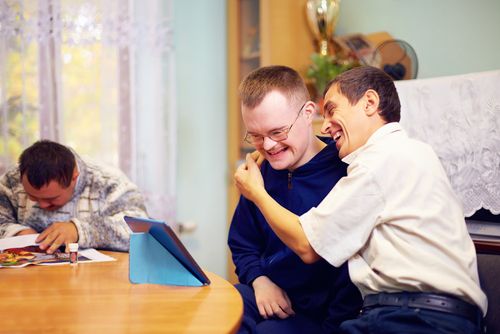
While there are a number of factors involved with creating an inclusive, engaging classroom for all students, especially those with special needs, the most important aspect to consider is what the individual requirements of each student using the classroom in any given school year might be.
Their IEPs combined with input from their parents, guardians, therapists, and medical team will help teachers and school administrators to ascertain the exact modifications, accommodations, and adaptations required to support these students.
Specially designed classroom furniture, seating options, and indoor/outdoor recreation equipment will help fulfill a wide range of needed adaptations and accommodations, along with assistive technology and augmentative communication devices for learning and development.
Children and teens living with learning or intellectual disabilities, sensory processing issues, physical challenges, and mobility impairments can all benefit with supportive and adaptive equipment in the classroom.
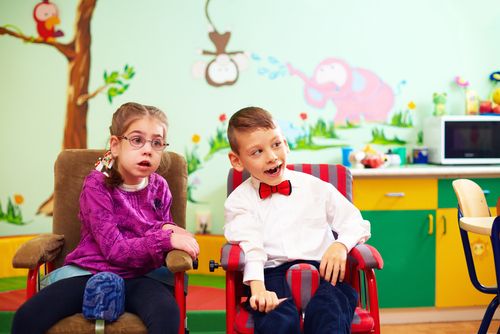
Providing specialized positioning and variable support for a multitude of different physical and mental needs, activity chairs are highly adjustable to accommodate many young users in the inclusive classroom.
The best activity chairs offer a wide variety of customization options to easily accommodate children with a range of differing support requirements.
Activity chairs can be used for children with mild to severe physical involvement, and may include beneficial features such as tilt-in-space, hi-lo access, multiple points of adjustment, positioning straps and pommels, plus seatbelts and other devices to keep children from falling out of the chair.
Some designs have standard or spring bases, enabling more movable choices to accommodate self-stimulating behaviors.
Active and specialized seating for inclusive classrooms include corner chairs, portable seating inserts, t-stools, and roll chairs.
All are designed to assist with specific intellectual, emotional, and physical needs, and help kids to focus, pay attention, learn, and retain the information. They encourage level eye-contact and interaction with their peers, enhancing social activity along with school work.
When learning to type on a keyboard, figuring out which keys are where and what they do can be a major challenge. But with adaptive keyboards, users of all ages can enjoy their computers to the fullest extent - and in ways you never thought of! For instance, did you know there are color-coded keyboards designed to make learning key positions easy? Or, were you aware that there are keyboards specially designed for users living with Dyslexia? And for older users or those with limited/impaired vision, there are large print keyboards with backlit letters for even greater visibility. No matter your specific needs or preferences, your perfect keyboard is out there!
Nowadays, it's become more important than ever to create welcoming spaces inside schools. Places where everybody has the same opportunities to learn and where every student feels understood and supported. New tools, techniques, and equipment, precisely designed to suit every student's specific needs and abilities are more accessible than ever. Our students deserve no matter their age or capabilities our best efforts for creating a school, institution, or space where they can truly experience a fair chance to learn and reach their maximal potential.
Logickeyboard is a renowned brand that over the years has confirmed many times its true desire of granting children of all ages, sizes, and abilities opportunities to be better. They've developed reliable devices that understand every child's challenges, weaknesses, and strengths and help them achieve their goals. Among special equipment that's helped students connect through technology and use it to learn and grow there are keyboards for vision-impaired users, braille users, and students being challenged by dyslexia. An example of the use of technology for inclusion, many schools have partnered with Logickeyboards to provide their attendees with sign language keyboards that help them learn and practice fluent communication with limited-hearing users.
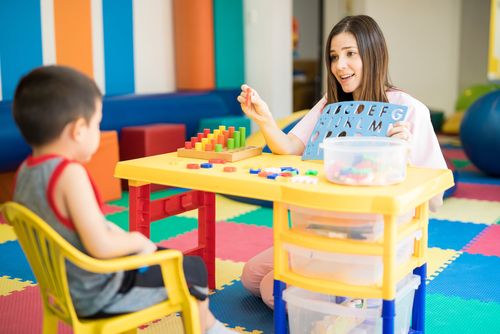
Encompassing a broad range of assistive technology and adaptive equipment, learning and development in inclusive classrooms is innovative, creative, and engaging for children with special needs.
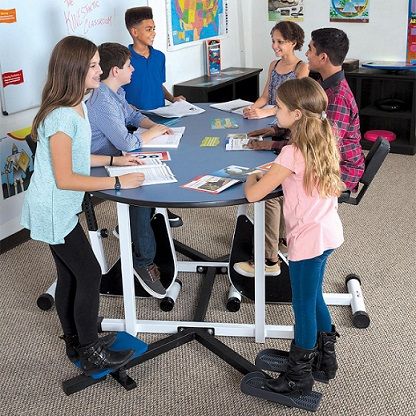
As an exciting new trend taking place in schools across the country, the kinesthetic classroom merges with the inclusive classroom to create a fun and engaging way for kids and teens to learn.
Utilizing motion chairs, standing tables, pedaling desks, and a host of other fun and functional equipment, kinesthetic classrooms tap into the natural tendency children have to move.
Encouraging youngsters to better develop their sense of balance (vestibular), sense of movement (kinaesthesia), and the sense of where their body is in space (proprioception), kinesthetic classroom equipment allows them to spin, pedal, ski, step/walk, fidget, rock, stride, and balance while they learn.
Nearly 80 percent of all students have high kinesthetic learning styles, but since all of us learn through movement, everyone is a kinesthetic learner to some extent. Children are almost always able to better concentrate and retain the information they’ve learned when they are active rather than sitting still, and kinesthetic learning incorporates movement and activity to boost attention, memory, focus, and cognition.
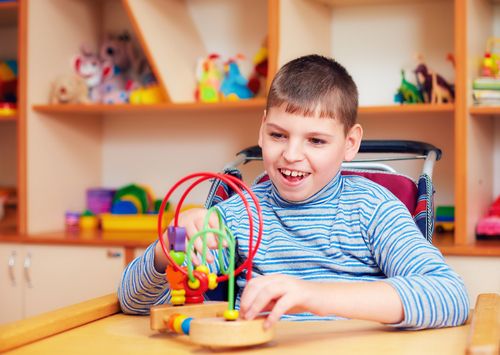
Adaptive classroom furniture comes in a wide range of styles and formats for both younger children and older teens, suiting an array of specific disabilities.
First and most important in most classrooms is the desk. But, most traditional desks aren’t very inclusive as they don’t accommodate users of different shapes and sizes.
Usually adjustable in height to accommodate different sizes of users or wheelchairs, innovatively designed tables, desks, and easels facilitate focus, attention, and ease of use for kids living with special needs. They can also often be used by children and teens without disabilities, as well.
School desks that allow wheelchair access are a must in inclusive classrooms, and enable children who use wheelchairs to get close to the desk in order to comfortably perform their schoolwork and other activities.
They may have a cut-out design, and are always height-adjustable to accommodate different wheelchair heights. Some computer desks are also wheelchair-accessible, and often feature two adjustable tabletops for the monitor and keyboard.
Tilting desks are also quite popular in inclusive schools, and provide convenient, versatile use. Offered in formats that also often accommodate wheelchairs, tilting desks and tables are height-adjustable, and facilitate perfect positioning and distance to stabilize the child’s head, eyes, and trunk.
Easels typically sit on top of other desks, tabletops, or the floor to provide an alternative workspace. They may be preferred over flat desks by kids living with certain kinds of conditions that make it more comfortable to use an inclined surface.
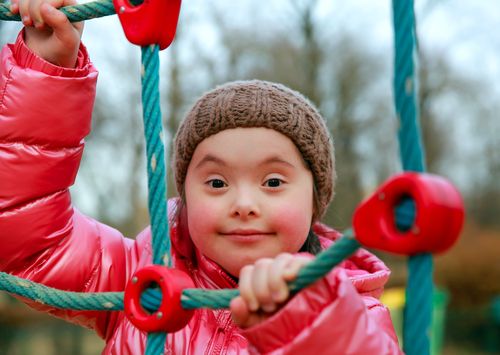
Recreation equipment for inclusive schools is made up of both indoor and outdoor gear to engage children in play and exercise.
Play is crucial to every child’s development, and provides a wealth of mental, emotional, and physical benefits for kids regardless of special needs.
Inclusive play helps foster social skills development and promotes cooperation and collaboration, while individual play enhances creativity and teaches kids how to enjoy alone time.
Outdoor recreational equipment allows you to create a delightful playground that attracts young users, helping them relax and have fun while they also boost their physical health, learning abilities, mental development, and psychological well-being.
Adaptive playground equipment and specially designed swing seats let special needs kids join in on the fun safely, and enjoy improved social interaction with their peers.
Indoor recreational equipment provides all of the same benefits as outdoor equipment, but is never dependent on the weather.
Offered in a diverse assortment of play activities, indoor gym equipment helps kids with or without disabilities to work off excess energy even when it’s raining or too cold outside to play.
Inclusive schools and classrooms are on the rise because they work!
When implemented correctly, inclusive classrooms have not demonstrated any negative effects, while research keeps showing the multiple benefits for everyone involved.
Special needs children and kids without disabilities both improve, while the general education and special education teachers enjoy less chaos, and better scholastic results with their students.
Creating an inclusive classroom that all students can learn in, regardless of learning, emotional, psychological, or physical limitations, ultimately leads to a more inclusive society where diversity is celebrated rather than feared. There are a number of ways to make schools more inclusive, especially with the use of adaptive and assistive equipment.
From the classroom to the playground, we’ve got your inclusive needs covered at Rehabmart. And, check out our other Caregiver University articles for more helpful information on how to care for kids with special needs, as well as more tips on how to promote inclusivity.

Co-founder/CEO of Rehabmart, Pediatric Occupational Therapist, husband, and father. Passionate about connecting special needs kids with superb nutrition, sensory integration, and complementary health strategies. Excited about Rehabmart's mission to become the premier online educational platform which empowers caregivers by spotlighting innovative devices and interventions to achieve optimal patient response and recovery.